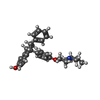[English] 日本語
 Yorodumi
Yorodumi- PDB-7ujw: Estrogen Receptor Alpha Ligand Binding Domain Y537S Mutant in Com... -
+ Open data
Open data
- Basic information
Basic information
| Entry | Database: PDB / ID: 7ujw | |||||||||
|---|---|---|---|---|---|---|---|---|---|---|
| Title | Estrogen Receptor Alpha Ligand Binding Domain Y537S Mutant in Complex with a Methylated Lasofoxifene Derivative that Possesses Selective Estrogen Receptor Degrader Activities | |||||||||
 Components Components | Estrogen receptor | |||||||||
 Keywords Keywords | TRANSCRIPTION / ESTROGEN RECEPTOR ALPHA / Y537S / ACTIVATING MUTATION / ANTIESTROGEN / ALPHA HELICAL BUNDLE | |||||||||
| Function / homology |  Function and homology information Function and homology informationregulation of epithelial cell apoptotic process / antral ovarian follicle growth / regulation of branching involved in prostate gland morphogenesis / RUNX1 regulates transcription of genes involved in WNT signaling / RUNX1 regulates estrogen receptor mediated transcription / regulation of toll-like receptor signaling pathway / nuclear estrogen receptor activity / epithelial cell development / steroid hormone receptor signaling pathway / prostate epithelial cord elongation ...regulation of epithelial cell apoptotic process / antral ovarian follicle growth / regulation of branching involved in prostate gland morphogenesis / RUNX1 regulates transcription of genes involved in WNT signaling / RUNX1 regulates estrogen receptor mediated transcription / regulation of toll-like receptor signaling pathway / nuclear estrogen receptor activity / epithelial cell development / steroid hormone receptor signaling pathway / prostate epithelial cord elongation / epithelial cell proliferation involved in mammary gland duct elongation / prostate epithelial cord arborization involved in prostate glandular acinus morphogenesis / mammary gland branching involved in pregnancy / uterus development / negative regulation of smooth muscle cell apoptotic process / vagina development / TFIIB-class transcription factor binding / androgen metabolic process / mammary gland alveolus development / cellular response to estrogen stimulus / estrogen response element binding / Mitochondrial unfolded protein response (UPRmt) / nuclear receptor-mediated steroid hormone signaling pathway / Nuclear signaling by ERBB4 / : / : / RNA polymerase II preinitiation complex assembly / positive regulation of nitric-oxide synthase activity / estrogen receptor signaling pathway / protein localization to chromatin / steroid binding / 14-3-3 protein binding / TFAP2 (AP-2) family regulates transcription of growth factors and their receptors / negative regulation of canonical NF-kappaB signal transduction / ESR-mediated signaling / negative regulation of miRNA transcription / TBP-class protein binding / nitric-oxide synthase regulator activity / nuclear estrogen receptor binding / transcription corepressor binding / transcription coregulator binding / stem cell differentiation / SUMOylation of intracellular receptors / cellular response to estradiol stimulus / euchromatin / beta-catenin binding / Nuclear Receptor transcription pathway / response to estrogen / transcription coactivator binding / male gonad development / nuclear receptor activity / positive regulation of fibroblast proliferation / Constitutive Signaling by Aberrant PI3K in Cancer / sequence-specific double-stranded DNA binding / positive regulation of nitric oxide biosynthetic process / Regulation of RUNX2 expression and activity / Ovarian tumor domain proteases / response to estradiol / PIP3 activates AKT signaling / positive regulation of cytosolic calcium ion concentration / ATPase binding / PI5P, PP2A and IER3 Regulate PI3K/AKT Signaling / regulation of inflammatory response / DNA-binding transcription activator activity, RNA polymerase II-specific / fibroblast proliferation / transcription regulator complex / phospholipase C-activating G protein-coupled receptor signaling pathway / Estrogen-dependent gene expression / DNA-binding transcription factor activity, RNA polymerase II-specific / calmodulin binding / Extra-nuclear estrogen signaling / RNA polymerase II cis-regulatory region sequence-specific DNA binding / chromatin remodeling / DNA-binding transcription factor activity / negative regulation of gene expression / chromatin binding / regulation of DNA-templated transcription / regulation of transcription by RNA polymerase II / protein kinase binding / chromatin / positive regulation of DNA-templated transcription / enzyme binding / negative regulation of transcription by RNA polymerase II / Golgi apparatus / signal transduction / positive regulation of transcription by RNA polymerase II / protein-containing complex / zinc ion binding / nucleoplasm / identical protein binding / nucleus / membrane / plasma membrane / cytosol / cytoplasm Similarity search - Function | |||||||||
| Biological species |  Homo sapiens (human) Homo sapiens (human) | |||||||||
| Method |  X-RAY DIFFRACTION / X-RAY DIFFRACTION /  SYNCHROTRON / SYNCHROTRON /  MOLECULAR REPLACEMENT / Resolution: 2.6 Å MOLECULAR REPLACEMENT / Resolution: 2.6 Å | |||||||||
 Authors Authors | Hosfield, D.J. / Greene, G.L. / Fanning, S.W. | |||||||||
| Funding support | 1items
| |||||||||
 Citation Citation |  Journal: Elife / Year: 2022 Journal: Elife / Year: 2022Title: Stereospecific lasofoxifene derivatives reveal the interplay between estrogen receptor alpha stability and antagonistic activity in ESR1 mutant breast cancer cells. Authors: Hosfield, D.J. / Weber, S. / Li, N.S. / Suavage, M. / Joiner, C.F. / Hancock, G.R. / Sullivan, E.A. / Ndukwe, E. / Han, R. / Cush, S. / Laine, M. / Mader, S.C. / Greene, G.L. / Fanning, S.W. | |||||||||
| History |
|
- Structure visualization
Structure visualization
| Structure viewer | Molecule:  Molmil Molmil Jmol/JSmol Jmol/JSmol |
|---|
- Downloads & links
Downloads & links
- Download
Download
| PDBx/mmCIF format |  7ujw.cif.gz 7ujw.cif.gz | 342.8 KB | Display |  PDBx/mmCIF format PDBx/mmCIF format |
|---|---|---|---|---|
| PDB format |  pdb7ujw.ent.gz pdb7ujw.ent.gz | 279 KB | Display |  PDB format PDB format |
| PDBx/mmJSON format |  7ujw.json.gz 7ujw.json.gz | Tree view |  PDBx/mmJSON format PDBx/mmJSON format | |
| Others |  Other downloads Other downloads |
-Validation report
| Summary document |  7ujw_validation.pdf.gz 7ujw_validation.pdf.gz | 1.4 MB | Display |  wwPDB validaton report wwPDB validaton report |
|---|---|---|---|---|
| Full document |  7ujw_full_validation.pdf.gz 7ujw_full_validation.pdf.gz | 1.4 MB | Display | |
| Data in XML |  7ujw_validation.xml.gz 7ujw_validation.xml.gz | 19.4 KB | Display | |
| Data in CIF |  7ujw_validation.cif.gz 7ujw_validation.cif.gz | 27.7 KB | Display | |
| Arichive directory |  https://data.pdbj.org/pub/pdb/validation_reports/uj/7ujw https://data.pdbj.org/pub/pdb/validation_reports/uj/7ujw ftp://data.pdbj.org/pub/pdb/validation_reports/uj/7ujw ftp://data.pdbj.org/pub/pdb/validation_reports/uj/7ujw | HTTPS FTP |
-Related structure data
| Related structure data |  6psjC 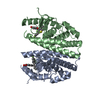 6v8tC 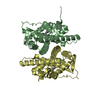 6vpfC  7kbsC  7uj7C  7uj8C  7ujcC 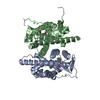 7ujfC  7ujmC 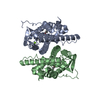 7ujoC  7ujyC  5ufxS S: Starting model for refinement C: citing same article ( |
|---|---|
| Similar structure data | Similarity search - Function & homology  F&H Search F&H Search |
- Links
Links
- Assembly
Assembly
| Deposited unit | 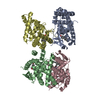
| ||||||||
|---|---|---|---|---|---|---|---|---|---|
| 1 | 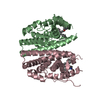
| ||||||||
| 2 | 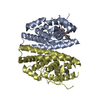
| ||||||||
| Unit cell |
|
- Components
Components
| #1: Protein | Mass: 30147.186 Da / Num. of mol.: 4 / Mutation: Y537S Source method: isolated from a genetically manipulated source Source: (gene. exp.)  Homo sapiens (human) / Gene: ESR1, ESR, NR3A1 / Production host: Homo sapiens (human) / Gene: ESR1, ESR, NR3A1 / Production host:  #2: Chemical | ChemComp-R3V / ( #3: Water | ChemComp-HOH / | Has ligand of interest | Y | |
|---|
-Experimental details
-Experiment
| Experiment | Method:  X-RAY DIFFRACTION / Number of used crystals: 1 X-RAY DIFFRACTION / Number of used crystals: 1 |
|---|
- Sample preparation
Sample preparation
| Crystal | Density Matthews: 2.02 Å3/Da / Density % sol: 39.16 % |
|---|---|
| Crystal grow | Temperature: 298 K / Method: vapor diffusion, hanging drop / Details: PEG 8,000, Tris pH 8.0, MgCl2 |
-Data collection
| Diffraction | Mean temperature: 100 K / Serial crystal experiment: N |
|---|---|
| Diffraction source | Source:  SYNCHROTRON / Site: SYNCHROTRON / Site:  APS APS  / Beamline: 19-BM / Wavelength: 0.987 Å / Beamline: 19-BM / Wavelength: 0.987 Å |
| Detector | Type: ADSC QUANTUM 210r / Detector: CCD / Date: Jun 19, 2019 |
| Radiation | Protocol: SINGLE WAVELENGTH / Monochromatic (M) / Laue (L): M / Scattering type: x-ray |
| Radiation wavelength | Wavelength: 0.987 Å / Relative weight: 1 |
| Reflection | Resolution: 2.59→50 Å / Num. obs: 25437 / % possible obs: 96.3 % / Redundancy: 1.8 % / Rpim(I) all: 0.04 / Net I/σ(I): 12.15 |
| Reflection shell | Resolution: 2.59→2.64 Å / Num. unique obs: 1373 / CC1/2: 0.601 |
- Processing
Processing
| Software |
| ||||||||||||||||||
|---|---|---|---|---|---|---|---|---|---|---|---|---|---|---|---|---|---|---|---|
| Refinement | Method to determine structure:  MOLECULAR REPLACEMENT MOLECULAR REPLACEMENTStarting model: 5UFX Resolution: 2.6→47.59 Å / Cross valid method: THROUGHOUT
| ||||||||||||||||||
| Displacement parameters | Biso max: 143.4 Å2 / Biso mean: 51.5961 Å2 / Biso min: 8.61 Å2 | ||||||||||||||||||
| Refinement step | Cycle: LAST / Resolution: 2.6→47.59 Å
|
 Movie
Movie Controller
Controller


 PDBj
PDBj




